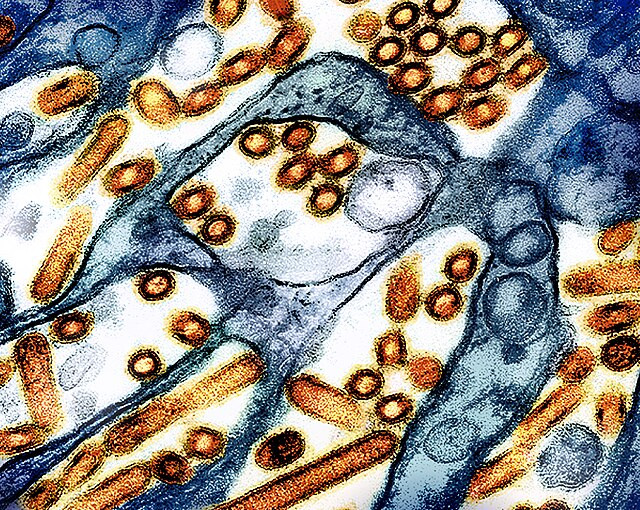Colorado has reported its seventh human case of bird flu this month, with the latest presumptive positive detected in a poultry worker. This uptick in human infections coincides with an ongoing outbreak among dairy cows, highlighting a potential new phase in the spread of the H5N1 virus.
The Colorado Department of Public Health and Environment announced that the seventh case is currently a presumptive positive, pending confirmatory testing by the Centers for Disease Control and Prevention (CDC). This individual worked at a poultry facility in Weld County, where six other workers had previously tested positive for the virus. These workers were involved in culling chickens infected with the highly pathogenic avian influenza, a strain of H5N1 closely related to the one affecting dairy cattle and dairy farm workers.
The US Department of Agriculture confirmed earlier this year that H5N1, which had been primarily spreading among wild birds, had made a significant jump to dairy cows in the US. To date, 168 herds in 13 states have tested positive for the virus, with human cases arising in several states including Texas, Michigan, and Colorado. This recent surge in human infections among Colorado poultry workers is particularly notable given that H5N1 has been affecting US poultry farms since January 2022, resulting in over 1,000 outbreaks across 48 states and impacting more than 100 million birds.
While genetic testing has not identified significant changes in the virus that could explain the recent increase in human cases, there remains no evidence of human-to-human transmission. The CDC continues to assess the risk of H5N1 to the general public as low, and all human cases so far have been mild, responding well to flu antivirals. However, federal officials noted that extreme summer heat might be contributing to the rise in cases, as poultry workers struggle to maintain protective gear like masks and goggles in high temperatures.
The exact mechanism of the virus's spread from dairy farms to poultry farms remains unclear. However, it is noteworthy that Colorado has reported the highest number of infected herds, with 46 of the country's 168 infected herds located in the state. Weld County alone has reported over two dozen infected herds, making it a significant hotspot for H5N1 transmission.
Public health experts are closely monitoring the situation in Colorado, especially after the cluster of cases among poultry workers at a single farm. Michael Osterholm, director of the University of Minnesota's Center for Infectious Disease Research and Policy, emphasized the need for more data to understand the risk. "If we get seven, or even 70 more cases of conjunctivitis, what does that mean? Could this be a precursor to a respiratory infection, to influenza being transmitted people to people? No one knows," Osterholm said.
The CDC recently confirmed a sixth case among Colorado poultry workers, and nearly 70 individuals involved in the culling operation were tested for H5N1 after showing symptoms. The cases so far have been mild, with symptoms ranging from fever and cough to conjunctivitis. This is the first instance of multiple human cases being reported on a single farm in the US, raising questions about potential changes in the virus or environmental factors that may facilitate its spread.
A study led by flu virologist Yoshihiro Kawaoka of the University of Wisconsin-Madison found that the virus circulating in cows has acquired some ability to bind to receptors in the human upper respiratory tract. This finding has raised concerns about the potential for human-to-human transmission, particularly in clusters of human cases.
In response to the outbreak, federal officials have highlighted the challenging conditions faced by workers in poultry facilities, where high temperatures and powerful fans make it difficult to wear protective equipment. Nirav Shah, the CDC principal deputy director, noted, "This confluence of factors may play a role in explaining why this outbreak occurred, where it did, and when it did."
Genetic analyses have indicated that the virus infecting the poultry workers is related to the strain spreading among cows, but it remains unclear which dairy farm it originated from. The state is conducting an investigation to understand these linkages and has requested additional support from the US Department of Agriculture.
Weld County, with a population of 350,000 and the highest concentration of dairies in the state, has been especially hard-hit by H5N1. Colorado State Veterinarian Maggie Baldwin noted the geographical factor, saying, "The fact that most of our dairies in Colorado are in the same region is going to lead to more transmission of this virus."
Colorado has been dealing with H5N1 outbreaks on its poultry farms since early 2022, but until this summer, those outbreaks were sporadic and linked to wild birds. The current situation, with sustained mammal-to-mammal transmission in dairy cows and spillovers into poultry operations, represents a heightened risk compared to the previous two and a half years.
Since its first reported case of bird flu in dairy cattle in late April, Colorado has recorded 41 additional H5N1-positive herds, with six in the past week alone. This means infections have been reported in 40% of Colorado's herds, making it the state with the highest number of livestock outbreaks in the USDA's official tally.






